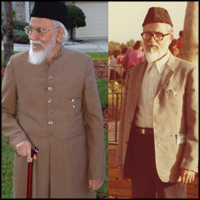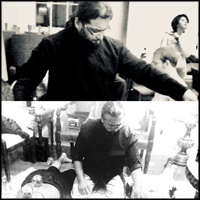The ancient healing art of wet cupping therapy is gaining prominence as advocates share their experiences about its benefits – and as more people seek a holistic treatment that achieves results on a subtle level to attain balanced good health. Incorporating wet cupping therapy into a medical practice was a logical step for Dr. Faisal Tawwab, whose practice – Multicare Physicians – offers it as a complement to allopathic (Western) medicine.
A board-certified physician, Dr. Tawwab operates his Lake Mary, Fla., practice with members of his family, all of whom are also board-certified physicians, each specializing in a different discipline. A graduate of Trinity Preparatory School, Winter Park, Fla., he graduated from Gulf Medical University in the United Arab Emirates with a Bachelors of Medicine and Bachelors of Surgery in 2009, after which he returned home to the United States to complete his Family Medicine Residency in Kentucky.
The dry cupping technique that is most familiar to the public involves applying a glass, plastic or silicone cup to the skin and creating a vacuum inside using heat, a squeezable bulb or a suction gun. The cup creates a vacuum that draws up the skin beneath, expanding the capillaries, improving oxygen supply and increasing the amount of fluid entering and leaving tissues – thereby promoting blood flow to sore areas in muscles.
The wet cupping process is similar, but involves the practitioner sanitizing the area to be treated, then making tiny superficial incisions in the skin using a surgical blade. The practitioner may heat the cups with a flame, then applies them to the skin or just a suction gun with disposable plastic cup. The suction draws out blood into the cups, which are left on the body for five to 10 minutes or longer. Skin discoloration and temporary bruising result.
However, the benefits of wet cupping are reported to be far longer-term than dry cupping, and have been well-documented over the past several thousand years of use in China, the Middle East and some eastern European countries. Dr. Tawwab cites many case studies of wet cupping therapy treating such ailments as migraines, depression, insomnia, sports injuries, chronic back pain, fatigue, irritable bowel syndrome, gastroesophageal reflux disease (GERD), cough, asthma and arthritis – among many others. He is currently conducting his own research in this field.
Western medical journals are now publishing studies that support historical accounts. One 2009 study published in Complementary Therapies in Medicine found that wet cupping significantly eased pain in patients with low back pain after a three-month follow-up.
Another study published in 2008 in the American Journal of Chinese Medicine found wet cupping alleviated migraine symptoms in patients with chronic headaches. Pain severity decreased by 66 percent, the number of headaches per month dropped to about 12.6 days and the need to medicate was lessened.
“You’re essentially removing the bad blood, which I refer to as ‘toxins” from specific acupuncture points that can provide relief to different areas of our body – which is why it should be performed by a well-trained physician,” said Dr. Tawwab.
Based on the principles of acupuncture and energy healing, wet cupping therapy draws out toxins, thereby reducing inflammatory substances. As does acupuncture, wet cupping operates on another, more subtle level by bringing the body’s energy centers into balance.

Dr. Tawwab became interested in wet cupping therapy during his recovery from a sports-related injury while a medical student in Dubai. His inspiration to pursue this healing art was, perhaps, to be expected, given his family’s tradition. Dr. Tawwab names his grandfather, Hakim Abdul Wahab Zhoori, as his greatest influence. He was the former principal of Nizamya Tibbi Medical College Hyderabad, India and lived to age 92, with his last 10 years spent with end-stage Alzheimer’s disease.
Throughout his distinguished career, he dedicated himself to the Unani system of medicine, the theoretical framework of which is based on the teachings of Hippocrates (460-377 BCE) and Galen. This system was subsequently developed into a comprehensive healthcare system by Arabic physicians, especially Ibn Sina (a.k.a. Avicenna). Hakim Abdul Wahab Zhoori was recognized as the foremost researcher in the field of Unani medicine, and his books remain in print in India and other parts of the world. His certain researched articles were translated into English and had been published in medical journals in England.
Spending more than 10 years studying and practicing wet cupping therapy under various teachers around the world, Dr. Tawwab’s travels led to London, where he found a mentor in renowned practitioner Irfan Sheikh. Dr. Tawwab credits Sheikh for teaching him the art of finding, balancing and enhancing chi, or life force – which is central to ancient forms of medicine and healing.
Having practiced wet cupping for over 10 years, Dr. Tawwab brings this treatment to his family’s medical practice. Coming from his family’s legacy of physicians,

“I think it’s very important to understand this isn’t some miracle cure for every ailment or disease, and it isn’t for everyone, as your experiences will vary,” says Dr. Tawwab. “This form of therapy has been around for centuries, and it is in my opinion the best tool for preventative health and wellness. “People use the term alternative medicine very loosely. I don’t think you should ever stop taking the medicine or treatment prescribed by your physician. But I do think healing therapies such as cupping go hand-in-hand supplementally or concurrently with medical treatment.”
To schedule a consultation with Dr. Tawwab, contact his office online at www.multicaredocs.com, or call 407-878-7990.

